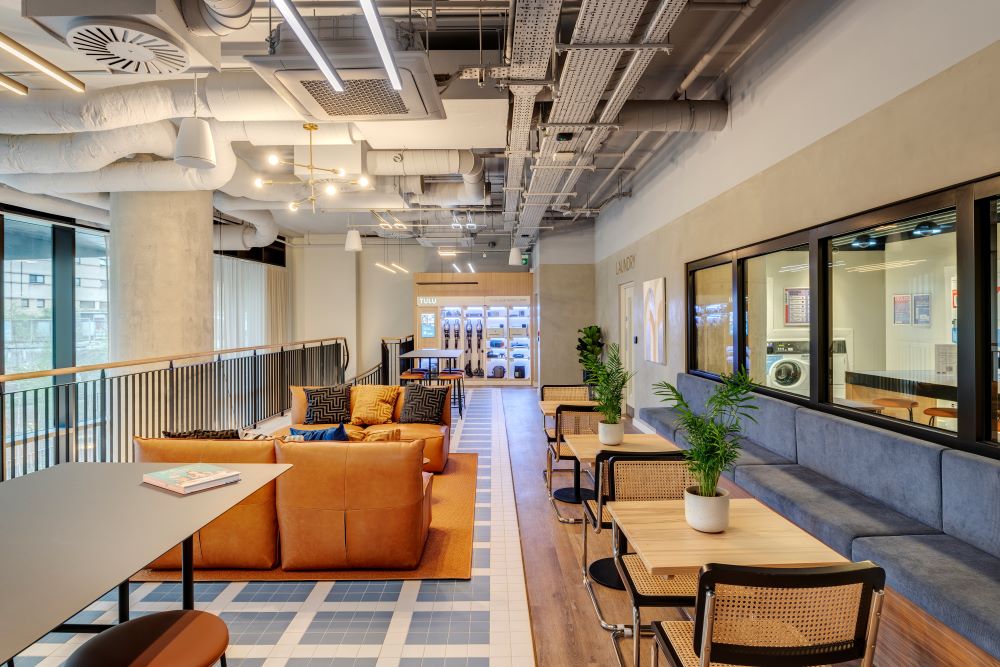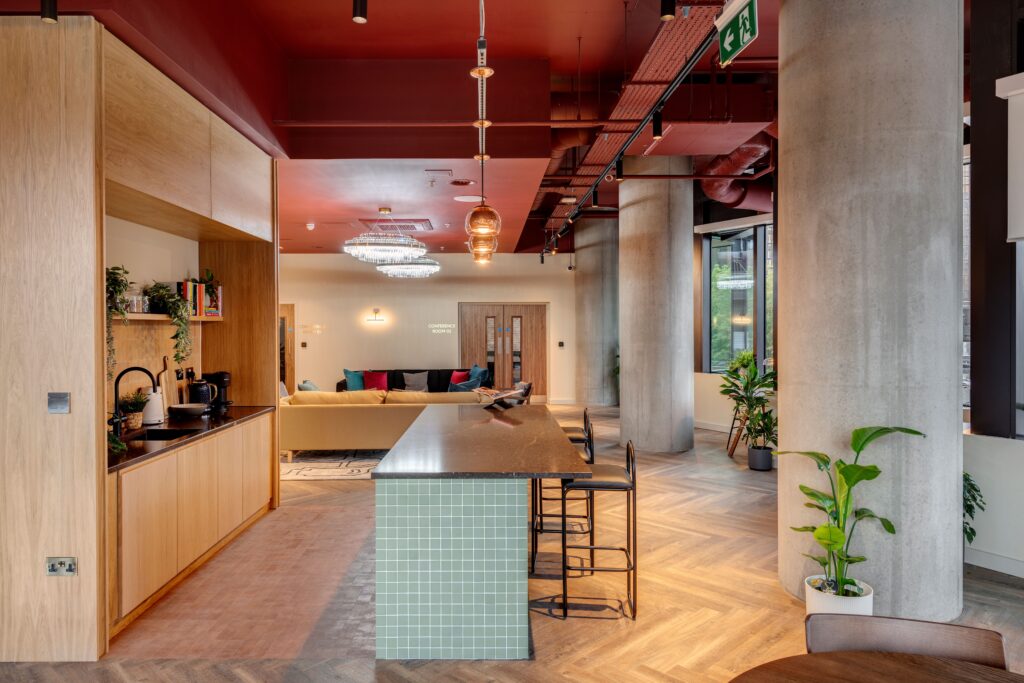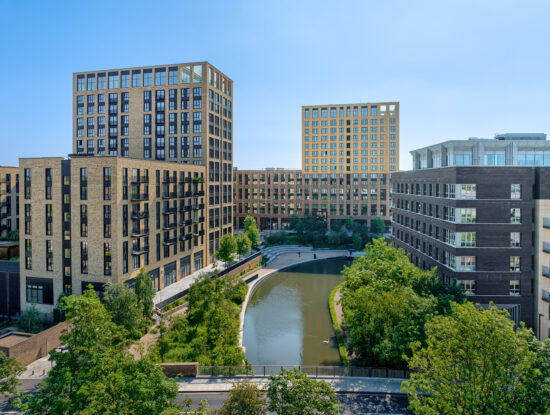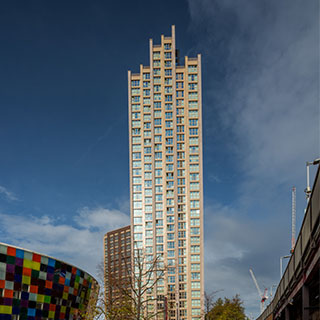Tide Construction has taken volumetric modular development to new heights with the construction of the 50-storey co-living scheme Enclave. Founder and chair John Fleming tells Andy Hillier about the firm’s latest developments and its plans for the future.
Looking out across London from the library room on the 48th floor of the Enclave co-living development in Croydon, south London, John Fleming is eager to point out the landmarks in the distance.
“That’s the City of London and Liverpool Street,” says the Tide Construction founder and chair . “Over there, you can see Wembley Stadium.”
It’s a sunny November day and the cityscape view from this height is stunning.
A year ago, Tide craned into place the last module of the 50-storey development on College Road. In the process, it also took the title of Europe’s tallest volumetric modular building, beating the record held by Tide’s 44-storey Ten Degrees build-to-rent development directly next door.
Tide is still putting the finishing touches to some of Enclave’s amenity areas and the adjoining 35-storey tower that will provide 120 affordable homes, but residents have already started to move into the 817 co-living apartments.
Factory production is far more efficient. It’s also easier to attract young people
In recent years, Tide has either completed or started work on 2,500 modular homes, working on behalf of some of the biggest investors in property, including Blackstone, Oaktree Capital Management and Greystar.
And at a time when industry players Legal & General (L&G) and ilke Homes have closed their offsite factories after struggling to turn a profit, Tide has made its modern methods of construction (MMC) model stack up financially. In the financial year to December 2022, it made a pre-tax profit of around £11m on an income of £177.5m.
Knowledge base
Sitting in the site office next to the College Road towers, Fleming, who founded his first building firm in his native Ireland back in his early twenties in 1973, says he believes the reason Tide has been able to make the MMC model work is its in-depth knowledge of the process.
Fleming started producing MMC buildings more than two decades ago in Ireland, before bringing the model to the UK 12 years ago.
“We concentrate very much on getting the product right,” he says. “Because of my background and my team’s background, we understand what is required on site. With MMC, you always have to consider that you’re delivering a building on site.”
Tide’s modules are produced at its Vision Modular Systems factory in Bedford before being transported to site and craned into place. The modules are built mainly out of steel, concrete and plasterboard, while the external facades use materials such as Rockwool and terracotta cladding.
“We are constructing a totally non-combustible building,” says Fleming. “I think we’ve thought the process through more than anybody else over the years. I also think what makes us different from everybody else is that we make it simple. We try to simplify rather than make it complicated – and we won’t take a chance on a material if we think it’s not well proven.”
Aside from its developments in Croydon, Tide’s other schemes under way include Greenford Quay, a major build-to-rent development in Ealing, west London, where it is constructing 1,380 homes on behalf of Greystar, and Marsh Wall, a 48-storey, 1,000-bed scheme in Canary Wharf, east London, that Tide claims will be the world’s tallest purpose-built student accommodation tower once completed.
A developer that’s spending millions on a build knows what they want. They’re not foolish
At the heart of Tide’s philosophy, says Fleming, is producing attractive spaces where people want to live, rather than creating bland, uniform boxes stacked on top of each other.
Looking around Enclave, there are no obvious signs of its modular construction. The co-living rooms and communal areas are divided into a variety of shapes and sizes, and halls and entrances flow like a regular modern apartment block. Seven floors are dedicated to amenity spaces and include a variety of kitchen and dining areas, the library, co-working spaces, a roof terrace, a music room, a poker room, a bar area and a gym and sauna. It is a far cry from the bolted-together shipping-container-style developments now used on some estates.
With construction costs up by around a third in less than two years, there is an argument that volumetric modular buildings could increasingly make financial sense for large-scale developers.
Fleming, though, is eager to play down the volumetric module being viewed as the cheap alternative to traditional construction.
“Construction cost inflation is the same for MMC as for conventional builders,” he says. “Where the stronger argument comes in now is that everybody wants a more environmentally friendly product. Our developments cut waste and carbon emissions by around 45% [compared with conventionally built developments]. That’s the strong argument for MMC – that and the quality of construction.”
Another big tick in MMC’s favour is the requirement for labour. “MMC uses less than 50% of the people on site,” says Fleming. “Factory production is far more efficient. It’s also much easier to attract young people to factories than it is to construction sites because of the comfort of working in a factory environment.”
In addition to the Bedford factory, Tide owns a facility in Merthyr Tydfil in Wales. However, the site closed during the Covid-19 pandemic and hasn’t reopened because of the ongoing economic slowdown.
Fleming concedes that the Welsh factory may never reopen, because the factory in Bedford now produces 45 modules a week – enough to satisfy its immediate needs. Also, Tide would ultimately like to have a facility capable of delivering 100 modules a week, which would require constructing a bigger factory.
Concrete is clearly on show at Enclave, but Fleming says Tide is well ahead of RIBA’s 2025 sustainability benchmark and close to achieving the 2030 target.

“The core [of Enclave] is concrete, but in the rest of the building, there is very little of it,” he says. “In our modules, we’re only using about 60% of the normal concrete floor of a conventional build.”
One material it does not plan to use any time soon is cross-laminated timber, even though there are growing calls for it to be used in larger-scale developments.
“We insist – and will always insist – that we build a non-combustible building,” says Fleming. “You can use cross-laminated timber in low-rise but when you start going above four or five storeys, it shouldn’t be considered a sturdy method of construction.”
Traditional approach
Despite MMC being used successfully in high-rise schemes, the vast majority of taller developments brought forward continue to use conventional techniques such as steel frames.
But rather than being frustrated at the industry, Fleming says he understands why developers stick with what they know. “The traditional system has served the industry very well for the past century – and will continue to do so for many years to come,” he says. “It’s not that the traditional system is doing anything wrong. There are very good-quality builders out there doing very good buildings.
“But obviously there’s a place for MMC. We’re trying to progress that and to show people how it can be done. We hope that more people will follow us and do what we’re doing in the future.”
Darting between the floors of Enclave with Fleming, it is clear he has some frustrations. Repeatedly he bemoans the number of kitchens Tide has been forced to install to meet planners’ co-living requirements.

His vexation is understandable: there are kitchens everywhere in the Outpost Management-owned Enclave. Every co-living apartment has a kitchenette, and there are full-size kitchens in almost all of the shared spaces.
“Investors like Greystar and Oaktree have several buildings in other locations and know exactly what they want in their building,” says Fleming. “But what we find with local authorities is that junior planners are trying to tell us what to do within the building. They almost want to redesign the building within.
But a developer that’s spending millions on a build knows what they want. They’re not foolish.”
He also believes the planning system should incentivise developments constructed off site, arguing MMC planning applications should be placed on a fast track. “They [MMC developments] cause less nuisance to the local people when you’re building and there are fewer traffic movements,” he says.
Planning hurdles
However, the current planning system threatens the viability of MMC because it can take years to gain approval, even when there is no opposition to schemes. He points to the fact that both L&G and ilke Homes cited planning issues as a reason behind the closure of their respective MMC factories earlier this year.
“In a factory where you have 300 people working, you need continuity of output,” he says. “With planning system delays and whatever, you haven’t the pipeline for your factory.
“In the conventional [construction] sector, planning is delayed and the construction workers go to another site nearby, but in a factory situation we can’t just tell people from Bedford to go down to London next week.”
The past year has been challenging because of the economic turbulence, but Fleming says Tide is on course to deliver a similar level of profit in 2023 as the year before, adding that it is often simpler to turn a profit in recessionary times because it is “easier to please subcontractors and suppliers”, compared with boom times ,when expectations are much higher.
The immediate target is to keep as much of Tide’s pipeline of 3,000 homes alive and follow the plan of the past 10 years to “keep busy”.
“We would like to double or triple our output in the next two to three years but it very much depends on the market,” he says.
“We had Covid. We now have a slowing down of investment because of high interest rates. There’s always something that affects the market.”
What is volumetric construction?
In volumetric construction, box-shaped modules are manufactured in a factory and then assembled on site to form a finished structure.
At Tide Construction’s Vision Modular Systems factory, modules are constructed using integrated structural steel framing and solid concrete floors. All internal finishes, windows and some external finishes are applied in the factory before being transported to site and craned into place.
Volumetric constructors claim using factory assembly makes it easier to deliver consistently high-quality spaces and reduces potential onsite delays due to factors such as bad weather or difficulties finding skilled construction staff. The aim is to complete more work indoors than is possible using panel-based MMC.
Photos: Taran Wilkhu and Richard Downer










